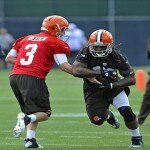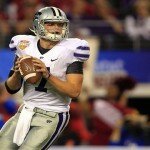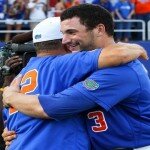Mike Zunino was the clear cut #1 catcher in the 2012 MLB Draft. Which team took him in the 2012 MLB Draft?
American East Draft Grades
Baltimore Orioles, B Grade: The Orioles made some solid picks. Kevin Gausman and Dylan Bundy could provide a Randy Johnson/Curt Schilling like one-two punch in the O’s rotation if both pitchers pan out in the major leagues.
I am sort of surprised that the Orioles passed on Stanford pitcher Mark Appel. Gausman is talented, but at the end of the day, I really do not believe he is in the same class as Appel.
Both pitchers have great accuracy and velocity on their pitches. Appel has better all-around physical ability.
Virginia pitcher Branden Kline is a project pitcher that could develop into a solid #2 or #3 starter. The Orioles took Kline in the second round of the 2012 MLB Draft. This seems like the perfect fit for Kline.
One more notable prospect that the Orioles took was South Carolina first baseman Christian Walker. Walker can develop into a #5 batter in a batting lineup.
Boston Red Sox, A Grade: The Red Sox got two first-round steals with shortstop Deven Marrero and pitcher Brian Johnson.
The Red Sox farm system has a future starting rotation in place with 2011 pitching prospect Matt Barnes. Barnes attended Connecticut and was a top 10 prospect that slipped to 19 due to great pitching depth in 2011. Barnes should be up on the Red Sox AA team shortly. Henry Owens is a South Paw arm from last year’s MLB Draft as well. Having Brian Johnson and 2012 second-round pick Pat Light as additional pitchers should bolster the Red Sox rotation with prospects with the Red Sox hoping to rebuild their rotation.
Florida reliever Austin Maddox could develop into a potential replacement for Jonathan Papelbon if he develops properly, but he needs more seasoning.
Ty Buntrey was a sandwich-round talent. I’m just curious how the Red Sox managed to land another steal in the fourth-round.
New York Yankees, B Grade: The Yankees made some solid picks, but none of their choices really wowed me. You can debate whether they out-drafted the Orioles.
At the end of Round 1, the Yankees selected Oklahoma high school pitcher Ty Hensely. Hensely is no Dylan Bundy or Archie Bradley in terms of his MLB draft range, but he does have the size and velocity to pitch a 4-seam fastball in the 96-97 mph range.
Outfielder Austin Aune has the versatility to play left fielder, center fielder, or right fielder. Miami FL catcher Peter O’Brien is another solid catcher. The Yankees have two solid bats that they can develop in their farm system.
Pitcher Corey Black was projected to go near the end of the fourth round. The Faulker University pitcher could end up a steal.
With the Yankees having the MLB’s best payroll, they can trade these prospects if there is a premium trading piece that would help the team win a world series in the short term.
Tampa Bay Rays, A- Grade: The Rays got a steal with Clemson infielder Richie Shaffer. He has outstanding leadership and the versatility to play anywhere in the infield. Shaffer could have gone as early as #5 overall and as late as #20 overall. The Rays got Shaffer at 25 which is clearly highway robbery. Shaffer has outstanding value as a bat. The only concern with Shaffer was durability with an injured hand coming out of high school. Shaffer seems to have corrected that aspect of his game, so it baffles me why he slipped so far.
Toronto Blue Jays, D Grade: The Blue Jays reached for a lot of players on draft day after having 5 of the top 60 picks and being the only team with 2 first-round choices in the top 31 overall.
AL East Draft Summary: The Yankees, Red Sox, and Rays should remain competitive in the AL East with the players they drafted. The Orioles can become competitive if Farm prospects Gausman, Bundy, and Kline all pan out as pitchers. With four teams competing in the AL East, the AL East teams could knock each other out of contention for the wild card spots.
American League Central Draft Grades
Chicago White Sox, B Grade: The White Sox made some solid picks. In Round 1, they got the top corner outfielder in Courtney Hawkins. Hawkins is an outfielder from Carroll High School. Carroll high is located in Texas. Hawkins was also the top high school power bat according to most MLB scouts despite his raw tools.
Georgia Southern pitcher Chris Beck provides great value as a Round 2 pick. I mocked Beck as a late first round prospect, so the White Sox are getting good value there.
Arizona State second baseman Joey DeMichele played next to shortstop Deven Marrero. DeMichele was an underrated player that complimented Marrero. I like the White Sox’ decision to add DeMichele in round 3.
The White Sox got some solid players in the first three rounds, but they did not get anyone who brought a wow factor.
Cleveland Indians, B Grade: The Indians, also known as the “Tribe” reached for boom or bust prospect with Texas A&M outfielder Tyler Naquin with the 15th pick. Most had Naquin in the 21-30 range on their final draft boards. Naiquin led the NCAA in hits and batting average. The reason he is so low on draft boards is because he is a tweener with corner fielder ability at best in the outfield. Naiquin could be the next MLB bust or the next Mike Trout. It sort of feels like the Indians’ front office rolled the dice by taking Naiquin here.
This sort of discouraged me initially because pitcher Lucas Giolito was once in the running to be the #1 overall pick, and was still on the board for the Indians at 15.
The Tribe got Mitch Brown a potential top 50 prospect according to some scouts with the 79th overall pick. Brown provided solid value, as a 2nd round pick, even though Georgia pitcher Alex Wood was the best player available at that point.
Kieran Lovegrove was a third to fourth-round pick from Mission Viejo High School, CA. The Indians took the California righty with the 110th overall pick in round 3.
In round 4, the Tribe got a steal. D’ Vone McClure should have been a second-round pick. McClure is a raw power bat with the upside to develop into in MLB center-fielder if he improves his field vision, speed, and defensive ability.
The Tribe took Western Nevada Community College pitcher Dylan Baker in Round 5. Baker was listed as a second-round prospect in Baseball America, but he was not in Jonathan Mayo’s top 100. The 6-foot-2 and 215-pound pitcher attends Western Nevada Community College. The Tribe is getting solid value with Baker.
Detroit Tigers, D Grade: It’s really difficult to be optimistic about the Tigers’ draft. They gave up their first-round pick for Prince Fielder and took a fourth-round talent with high school arm Jake Thompson as a second-round pick.
Kansas City Royals, D- Grade: The Royals reached for San Francisco pitcher Kyle Zimmer with the fifth-overall pick. It’s hard to justify the selection because Zimmer encountered some injuries in 2011. Zimmer was graded out as my ninth best player. The Royals hinted that they wanted a college pitcher, and Appel was still on the board. Zimmer had the chance to take the mound against Appel but didn’t due to injuries. Zimmer did defeat 2011 #1 overall pick Gerrit Cole in a pitching duel back in 2011.
In Round 2, the Royals took an undersized lefty from Vanderbilt. He was a fifth-round prospect. The Royals may have a good farm system, but they need to bring in a new scouting department.
The main reason the Royals salvaged an D grade was because of the Kenny Diekrogger pick in the fourth round. The Stanford shortstop was once considered a top 5 draft pick after his freshman season. Diekrogger’s performance over the last two seasons caused him to slip to this spot. The Royals took high school catcher Chad Johnson in the fifth round.
I tried to remain positive about the Royals, for the past two seasons praising their farm system. The Royals’ players from their stacked farm system in previous seasons, have yet to translate a winning product in the MLB. The Royals’ last two first-round picks in 2011 and 2012 have made me wonder if they will ever win until a new scouting department takes control.
Minnesota Twins, C Grade: You cannot completely criticize the Twins organization for taking Byron Buxton over Mark Appel at this stage. In one game Buxton went 4 for 4 leading the Appling County Pirates to a 10-0 win through 5 innings of play. The game ended one inning early mainly due to Buxton’s play.
I just get the feeling that when all is said and done, Appel and Mike Zunino could be All-Pros while Buxton is just another Joe. Buxton has immense potential. My biggest concern is that he could need at least five or six seasons to develop in the minors.
The upside is that Buxton could either end up being the next big five tool bat like Bryce Harper, Andrew McCutchen, or Jason Heyward as a center fielder. The downside is he could also be a five-year project in the minors before he makes the jump to the majors. Buxton may not be ready to make the jump to AA until 2015. Is it really worth it to spend a top 2 selection on a player that may not be up in the majors until 2017? I don’t think it is, but that’s just my two cents.
The Twins reached for two pitchers in sandwich-round. The Twins will need to compete for Florida Gators pitcher Karsten Whitson who will be the top prospect in the 2013 MLB Draft. Whitson was a top ten pick in high school back in 2010, but he decided not to sign with the San Diego Padres. One player who could challenge Whitson is Arkansas ace Ryan Stanek.
AL Central Summary: The AL Central is going to be up for grabs. The Tigers have the payroll to take the division, the White Sox drafted the safest players, and the Indians drafted the players with the most potential. The central should remain a three-horse race between the Tigers, White Sox, and Indians moving forward.
American League West Draft Grades
Los Angeles Angels, A+ Grade: The Angels did not pick until Round 3. When they were on the clock, they took R.J. Alvarez, a Florida International closer who can pitch a 95 mph 4-seamer and a 97 mph 2-seamer. Alvarez was a second-round talent and he can improve the velocity of his pitches with time in the bullpen. The problem with Alvarez is he’s undersized. When I watch Alvarez, Pittsburgh Pirates closer Joel Hanrahan is the most notable player comparison that comes to mind.
Oakland Athletics, F Grade: After obtaining steals like Michael Choice and Sonny Gray in the first round over the last two seasons, the Athletics resort to reaching for Addison Russell with the 11th pick. Deven Marrero and Gavin Cecchini both would have been better choices. The Athletics also reached for players outside of the first round.
Seattle Mariners, A+ Grade: The Mariners needed a bat. The Mariners got their bat with Florida Gators catcher Mike Zunino. Zunino was graded out as my top college bat for the 2012 MLB Draft.
Texas Rangers, A+ Grade: The Rangers have a top 5 MLB payroll, one of the league’s best rosters, a strong rotation, an outstanding farm system, and they take the best player on the board regardless of where they pick.
Lewis Brinson, Joey Gallo, Collin Wiles, Jarmon Jamie, and Nick Williams were all great choices.
The Rangers opened the 2012 MLB Draft by taking Brinson a future MLB bat out of Coral Springs, FL in Round 1. The Rangers then added Joey Gallo, a third baseman from Bishop Gorman High School, in Nevada. Williams got compared to Albert Pujols and was considered the #2 prospect in the entire 2012 MLB Draft at this point last year. The Rangers did an outstanding job securing more pieces to their system.
AL West Summary: Everyone except the Athletics had an outstanding draft in the AL West. The West will remain one of the more intriguing divisions in the American League.
American League Summary: There were not any big game-changing moves to shake the course of the American League. The Yankees, Red Sox, Rangers, and the AL Central winner should make up the typical AL Playoff picture. The Rays, Angels, Orioles, and Mariners are all potential candidates to battle for that fifth and final wild card spot down the road for years to come.

















